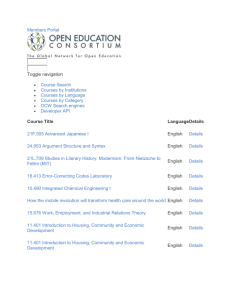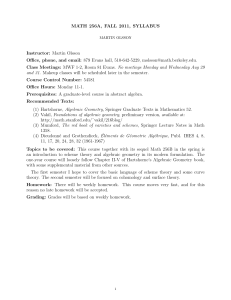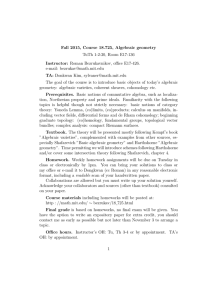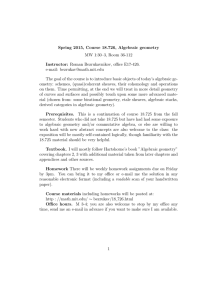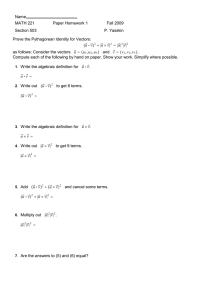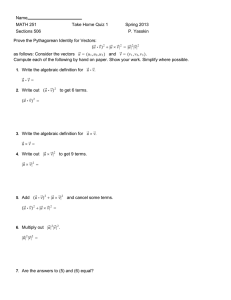TITLES AND ABSTRACTS OF TALKS FOR THE ANNUAL IMS MEETING,
advertisement
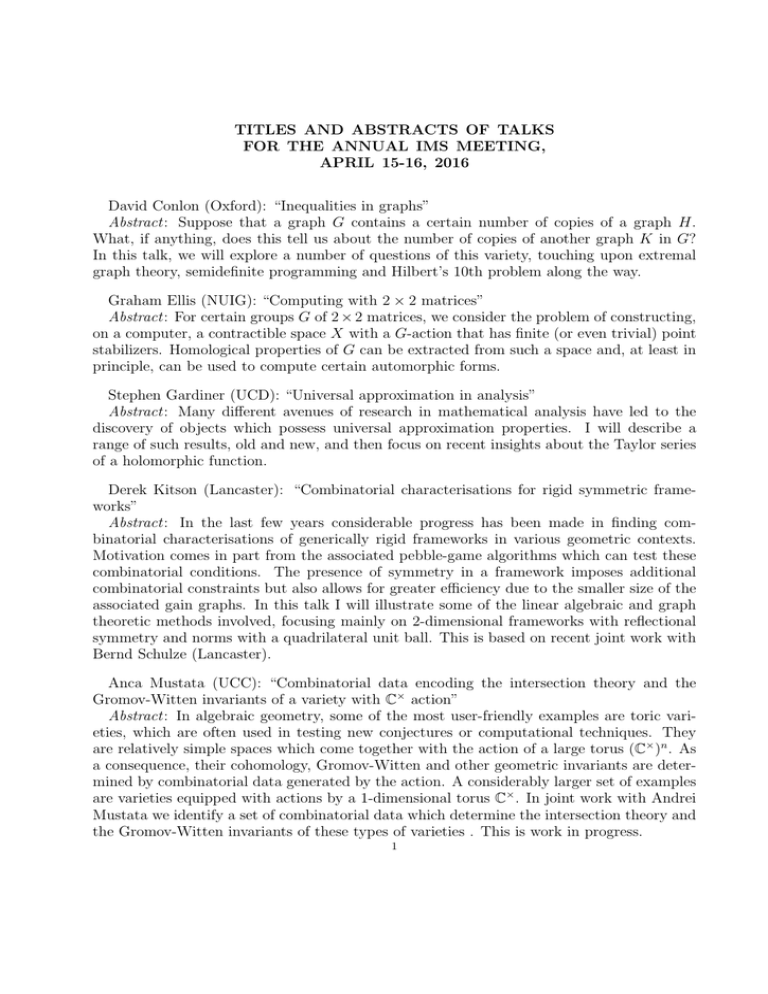
TITLES AND ABSTRACTS OF TALKS FOR THE ANNUAL IMS MEETING, APRIL 15-16, 2016 David Conlon (Oxford): “Inequalities in graphs” Abstract: Suppose that a graph G contains a certain number of copies of a graph H. What, if anything, does this tell us about the number of copies of another graph K in G? In this talk, we will explore a number of questions of this variety, touching upon extremal graph theory, semidefinite programming and Hilbert’s 10th problem along the way. Graham Ellis (NUIG): “Computing with 2 × 2 matrices” Abstract: For certain groups G of 2 × 2 matrices, we consider the problem of constructing, on a computer, a contractible space X with a G-action that has finite (or even trivial) point stabilizers. Homological properties of G can be extracted from such a space and, at least in principle, can be used to compute certain automorphic forms. Stephen Gardiner (UCD): “Universal approximation in analysis” Abstract: Many different avenues of research in mathematical analysis have led to the discovery of objects which possess universal approximation properties. I will describe a range of such results, old and new, and then focus on recent insights about the Taylor series of a holomorphic function. Derek Kitson (Lancaster): “Combinatorial characterisations for rigid symmetric frameworks” Abstract: In the last few years considerable progress has been made in finding combinatorial characterisations of generically rigid frameworks in various geometric contexts. Motivation comes in part from the associated pebble-game algorithms which can test these combinatorial conditions. The presence of symmetry in a framework imposes additional combinatorial constraints but also allows for greater efficiency due to the smaller size of the associated gain graphs. In this talk I will illustrate some of the linear algebraic and graph theoretic methods involved, focusing mainly on 2-dimensional frameworks with reflectional symmetry and norms with a quadrilateral unit ball. This is based on recent joint work with Bernd Schulze (Lancaster). Anca Mustata (UCC): “Combinatorial data encoding the intersection theory and the Gromov-Witten invariants of a variety with C× action” Abstract: In algebraic geometry, some of the most user-friendly examples are toric varieties, which are often used in testing new conjectures or computational techniques. They are relatively simple spaces which come together with the action of a large torus (C× )n . As a consequence, their cohomology, Gromov-Witten and other geometric invariants are determined by combinatorial data generated by the action. A considerably larger set of examples are varieties equipped with actions by a 1-dimensional torus C× . In joint work with Andrei Mustata we identify a set of combinatorial data which determine the intersection theory and the Gromov-Witten invariants of these types of varieties . This is work in progress. 1 Andreea Nicoara (TCD): “Connections between several complex variables and real algebraic geometry” Abstract: While fundamental questions in complex analysis in several variables such as the Levi problem drove much of the development of complex algebraic geometry in the 20th century, it turns out real algebraic geometry is considerably more relevant to complex analysis these days. I will explore these connections between complex analysis and real algebraic geometry arising from the study of the most famous PDE in complex analysis, the ¯ ∂-equation on a domain in Cn . Ann O’Shea (NUIM): “Understanding Understanding” Abstract: The main aim of most mathematics courses at third level is to develop students’ conceptual understanding. However, it is not easy to define this type of understanding. In this talk, I will consider attempts at coming up with such a definition and how these attempts can help us to study how learning takes place. I will use data from joint research projects with researchers in Ireland, the UK and Sweden. Rachel Quinlan (NUIG): “I almost wish I hadn’t gone down that rabbit-hole. . . ” Abstract: Our story starts in 1773, with an observation by Lagrange on 3 by 3 determinants. In 1833 the corresponding statement was proved by Jacobi for all square matrices, and it is now known as the Desnanot-Jacobi identity. It is the basis for Dodgson’s Condensation Algorithm of 1866, which is a scheme for computing determinants by repeatedly replacing contiguous 2 × 2 submatrices by the corresponding minors. More than 100 years later, the insertion of an experimental tweak to the definition of a 2 × 2 determinant in the condensation formula led to the notion of a λ-determinant. This is an adaptation of the determinant in which distinct products of matrix entries are indexed not by permutations but by more general objects known as alternating sign matrices (ASMs). This talk will present some of the surprising but compelling connections between ASMs and permutations, and mention some some apparent connections to other structures from enumerative combinatorics. Stuart White (Glasgow): “Quasidiagonality and Amenability” Abstract: Quasidiagonality of a family of bounded operator was introduced by Halmos in terms of simultaneous blockdiagonal approximations. Despite it’s simple definition, it’s somewhat mysterious, with a kind of topological flavour, and unexpected connections to other concepts. For example, in the late 80’s Rosenberg observed a connection to amenability of groups; showing that if the left regular representation of a discrete group is quasidiagonal, then the group must be amenable, and conjectured the converse. I’ll survey quasidiagonality and Rosenberg’s conjecture without assuming a background in operator algebras, and if time allows discuss it’s role in the classification of simple nuclear C*-algebras. 2
